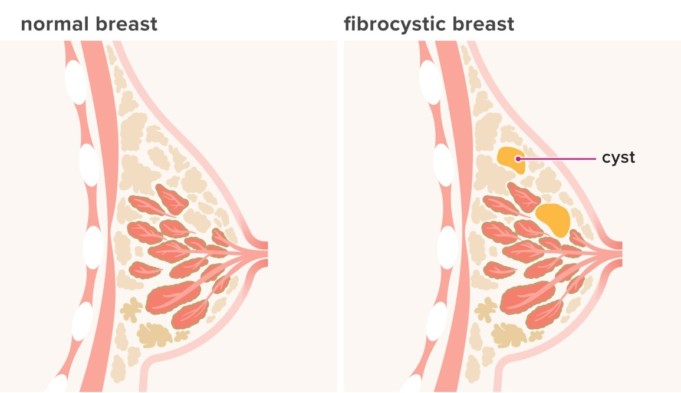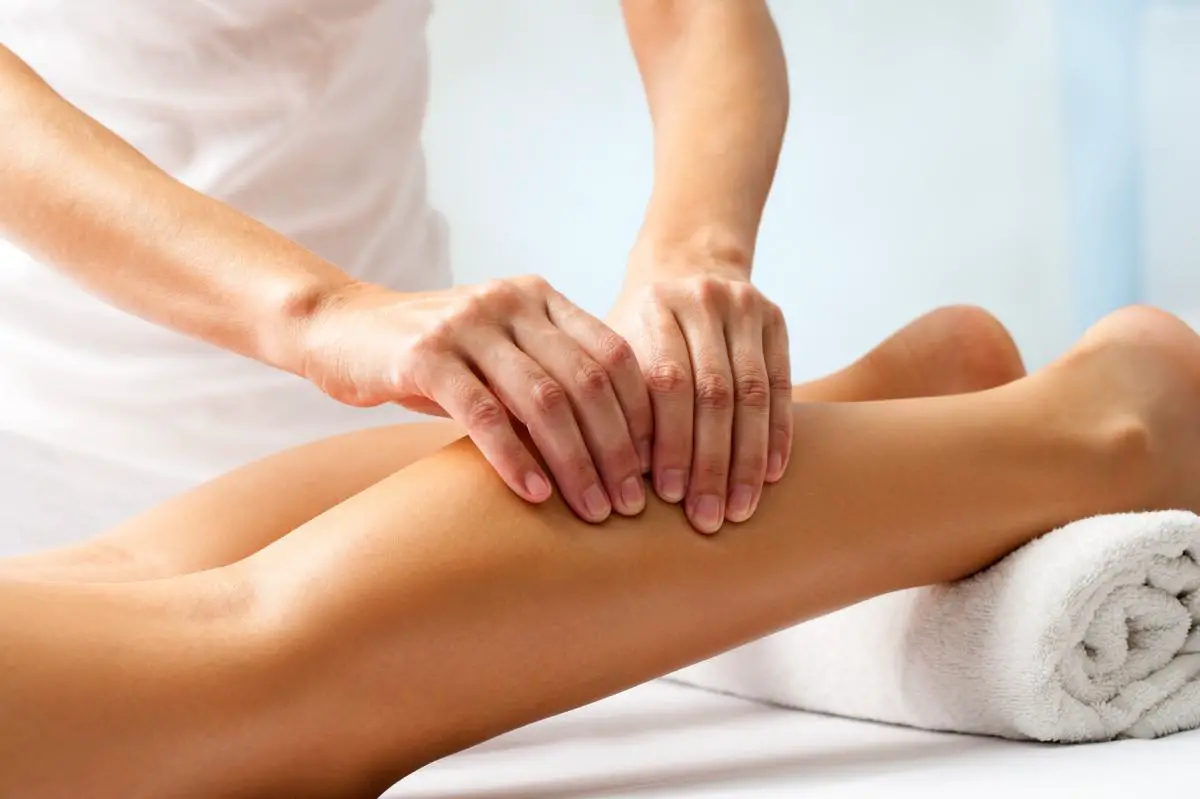Fibrocystic breast disease is also known as Nodular or glandular breast tissues. Although, it is not regarded as a disease, it is still called a disease by many.
It happens when the tissues of the breast become sore, lumpy, or have a rope-like texture. This condition is quite common as a lot of women experience a fibrocystic change in their breasts at some points in their lives.
This is the reason why most health experts don’t call this a disease. They consider these changes are normal. However, some don’t. This is because it causes discomfort to an extent and it can even progress to cancer in some cases.
Although some women with fibrocystic breasts don’t experience symptoms, most women do. Some of the symptoms experienced are lumpiness, breast pain and tenderness, etc.
Lumpiness is mostly experienced in the upper part of the breasts and also in the outer region of the breast.
Symptoms of Fibrocystic Breasts
- General breast pain and tenderness
- Breast lumps.
- Some areas of the breasts thicken and this tries to blend into the surrounding breast tissues
- Similar changes in both breasts
- Breast lump that changes in size with menstrual cycle
- A monthly increase in breast lumpiness or pain. This starts from ovulation to before your period.
- Dark brown or green discharge that is non-bloody.
- Nipple discharge that leaks without squeezing or adding pressure to the breasts.
Even though these changes are termed “normal”, I would advise you don’t take them likely. At this stage, you need to change many things in your live (your lifestyle and diet) to prevent these from progressing into breast cancer.
This condition affect women from 20 to 50 years but it hardly affects post-menopausal women, except those on hormone therapy.
Seek for help immediately you notice the following symptoms:
- The breast lump seems to be bigger or change
- These breast changes persists after your period
- The affected area continue to get worse
- A new breast lump appears
- A new area of prominent thickening
Even from the beginning, you shouldn’t see this as normal. You have to start working on balancing your hormones as early as possible to prevent a progression into breast cancer which is on the rise these days.
This condition can even make it hard to detect breast cancer. Also, some fibrocystic breasts have the changes that can be considered a risk factor for breast cancer.
Causes of Fibrocystic Breasts
Even though the exact cause of fibrocystic breast is not yet known, hormone imbalance is behind most cases of this disease.
Reproductive hormones, most especially estrogen, are responsible for these changes. Estrogen fluctuates during your menstrual cycle, these leads to discomfort, lumpiness, swollen, and sore breast.
The tissues of fibrocystic breasts when examined under a microscope have different components from a healthy tissue. You would notice that they have:
- Adenoids (enlarged breast lobules)
- Cysts (round or oval sacs filled with fluid)
- Hyperplasia (overgrowth of cells). These lines the Lobules (milk ducts) of the breast. These are the tissues responsible for producing milk.
- Fibrosis (a distinguished scar-like tissue)
Effective Home Remedies for Fibrocystic Breast
Many women have found relief from this condition by correcting their diet and lifestyle. Reduce your intake of caffeine, eat a low fat or low calories diet, increase your intake of essential fatty acids and walk often. This will reduce the symptoms and risks of breast cancer.
Other effective remedies you can try at home are:
Decrease your intake of fats
This would reduce your symptoms of fibrocystic breasts. This would also alter other factors related to mastalgia (breast pain), e.g. mammographic breast density.
If you have this condition, your daily fat intake should be less than 20% of your total daily caloric intake.
Avoid caffeine
You have to eliminate caffeine from your diet or at least reduce its intake. This will eliminate the breast pain. It can even give you total relief if you stop taking caffeine for at least one year.
Stop smoking
Quit smoking and also try to avoid second-hand smoke. Studies have associated smoking as a factor for mastalgia (breast pain).
Vitamin E
This nutrient reduces the size of breast cysts and breast tenderness. Increase your intake of vitamin E-rich foods such as nuts and seeds. It also relieves breast pains.
You can also get vitamin E from green leafy vegetables.
Flaxseed oil
Flaxseeds are highly effective in treating fibrocystic breasts. Moderate amount of this beneficial oil can control your levels of estrogen. It would keep it low.
Overtime, this would reduce the symptoms of fibrocystic breasts.
Primrose oil
This essential oil has a lot of benefits on fibrocystic breasts. It is rich in a unique mixture of essential fatty acids. It is highly dense in gamma-linolenic acid. This compound reduces autoimmune inflammations.
Apply a little quantity of this oil over the limps and this will reduce the symptoms you are experiencing.
Iodine
Thyroid function is closely related to fibrocystic breasts. Iodine supports the functions of the thyroid gland. This will help to reduce pain, limit the development of cysts, and also prevent the side effects of thyroid dysfunction on the breasts.
Increase your intake of iodine-rich foods. In severe cases, you can take iodine pills or Lugol’s iodine drops.
Hormone treatment
If you are currently on hormone treatment and experiencing this problem, you have to speak with your doctor. He/she has to adjust your dose or take you off the medication.
Heating pads
This is an effective home remedy for fibrocystic breasts. It works wonders for sore muscles and sore breasts. It also helps the surrounding area of your breasts.
Lie down and place a heating pad directly on your shirt over your breast. This would relax your muscles and relieve pains. Don’t place the heating pad directly on the breast.
And don’t lie down directly on the heating pad. Also, don’t fall asleep with it.
Hydrotherapy
A little hydrotherapy at home can help relieve the symptoms of this condition. One of the methods to try is the alternate compress. Apply a heat compress on your breasts for 30 minutes and then a cold compress for 10 minutes.
This will eliminate all discomforts. You can also choose to do only cold compress, this would eliminate the pains and tenderness. Put a bag of frozen peas over the affected breasts for 10 minutes.
You can also use ice cubes or some crushed ice cubes in a plastic bag. You can also place cold cabbage leaves over the breast at night. This will relieve pain and breast tenderness.
Warm compress also relieves swellings and pains in the breasts.
Sea vegetables
They are rich in iodine. This can help reduce the symptoms. Studies have linked iodine deficiency with breast lumps. Increase your intake of these vegetables so that you won’t develop breast lumps.
Examples of sea weeds are nori and kelp. You can get them in a good health store. You can use them also as a substitute for salt. Also, don’t consume table salt few weeks to your period, it causes water retention in the body.
This can make your breasts to become tender and heavy. Salt worsens the symptoms of fibrocystic breasts and also causes bloating. Avoid processed foods also, they are high in salt.
Massage
Massage your breasts regularly, this helps a great deal. It increases the flow of blood to your breasts, prevents the formation of lumps, and also relieves the symptoms of fibrocystic breasts.
Use oils to massage your breasts, this makes it more effective. Oils I can recommend for this condition are ginger essential oil, olive oil, and coconut oil.
For a fast result, do a warm compress after breast massage.
Vitamin A
Increase your intake of vitamin A-rich foods. Some studies have shown that a deficiency in this vitamin leads to breast pain. Therefore, increasing your intake of this vitamin will reduce the pain.
Eat fruits and vegetables that are red, yellow, and orange in color. They contain beta-carotene which your body converts into vitamin A. It is also water soluble, so excess of it can be flushed out of the body.
So have no fear that you will eat excess of vitamin A.
Increase your intake of green vegetables
Eat lots of green vegetables like cabbage, cucumbers, and parsley. They are natural diuretics. They help to eliminate excess water from your body. Commercial diuretics have adverse side effects.
They deplete the stores of potassium in your body. This can cause an imbalance in the levels of electrolytes. This will cause major problems in the body and also affect the production of glucose.
Increase your intake of fiber
Fiber controls the levels of hormones. It prevents fluctuations which can lead to this condition. Rich sources of fiber are green leafy vegetables, fruits, beans, whole wheat bread, and brown rice.
Garlic
Garlic improves the levels of oxygen in your body, this can stop these changes going on in your breasts. Take at least three raw cloves of garlic daily.
Peel the cloves and cut them into tiny pieces. Expose these cut pieces to air for few seconds and swallow them using a cup of warm water.
Other herbs that promote oxygenation of cells are onions and mushrooms. Garlic is also rich in vitamin B6, this nutrient also regulate the levels of hormones. Other rich sources of B6 are pistachio and bran.
Fish
Oily fish rich in omega-3 fatty acids are beneficial to women suffering from fibrocystic breast. They are rich in iodine and this would help to prevent the formation of breast lumps.
Include a moderate amount of oily fish in your diet. Examples are salmon, trout, and mackerel.
Apple cider vinegar
This is a safe and highly effective home remedy for fibrocystic breasts. It relieves inflammation and other symptoms of fibrocystic breasts.
Add two tablespoons of ACV to a glass of water and drink. Do these three times daily or as many times as you can until the symptoms goes away.
With the above remedies, fibrocystic breasts will be a thing of the past.
Sources;
- Natural Approaches to Fibrocystic Breasts Dr. Tori













